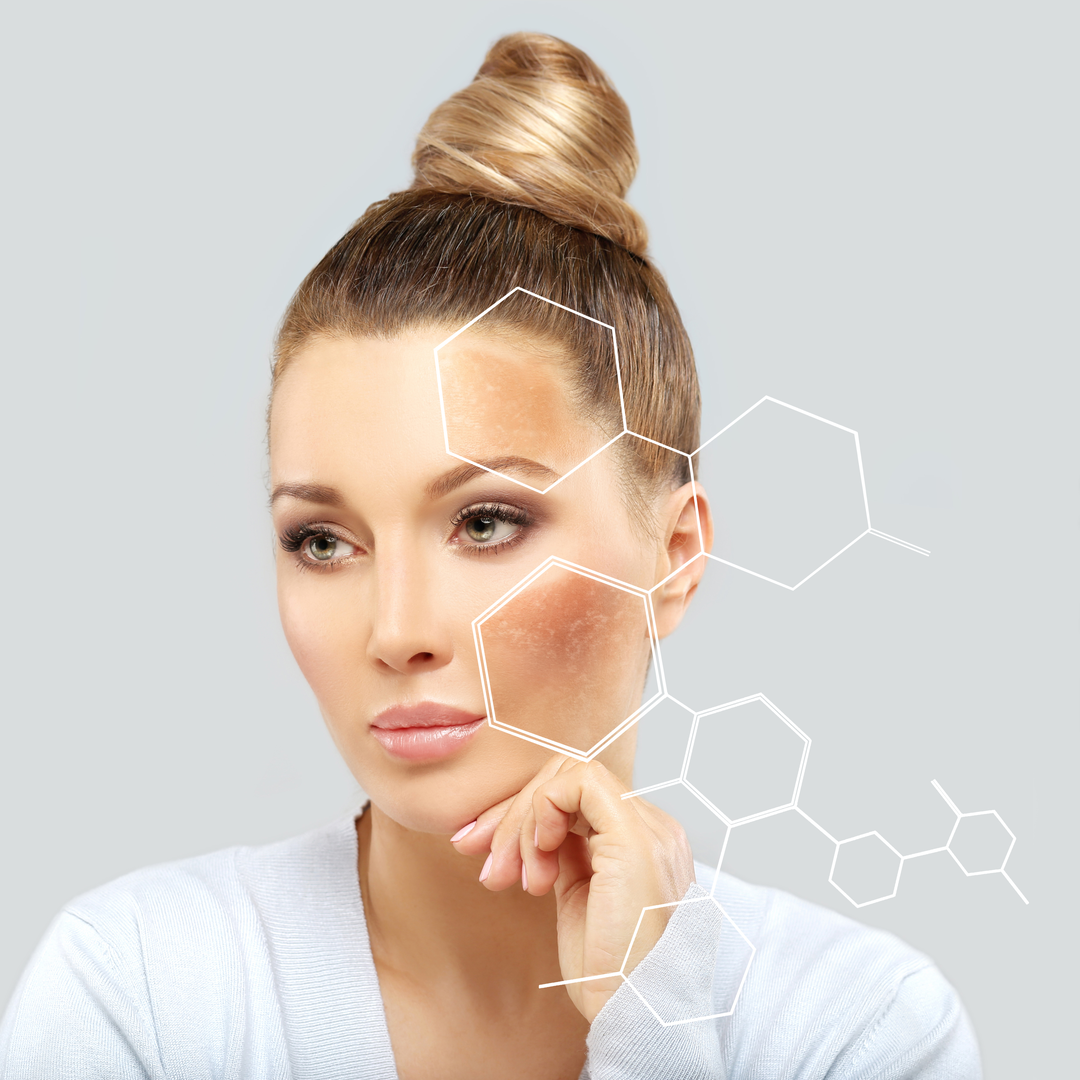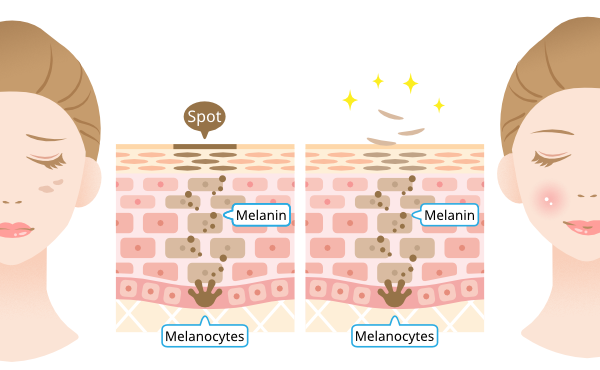
Last week we talked about some things we can do to change our “spots” – sunspots, age spots, melasma and the like.
What is Hyperpigmentation?

Melanin, which determines the overall pigmentation in our skin, concentrates to make dark spots. (When melanin under produces it can cause lighter spots which is hypopigmentation.)
However, there are a number of things that can cause hyperpigmentation and it’s worth evaluating with your dermatologist before you move onto these next items.
In a nutshell, hyperpigmentation is most often from:
- Sun Exposure – sunlight triggers the production of melanin (think: tanning) in the first place. It’s actually part of our body’s protective mechanism against harmful UV rays. More sun = more melanin = more potential for spots. This is why people who are fighting their spots need to be best friends with sunscreen.
- Hormones – credited often as the source of melasma, our hormones can overstimulate our melanin production (think: pregnancy mask).
- Age – like many things that slow down and get screwy as we “grow wiser”, our melanocytes get sluggish and decrease, which kicks the remaining ones into overdrive (think: age spots).
- Injury – after we have skin injuries or inflammation, we can have darker spots left behind (think: cuts, burns, acne).
- Medication and Disease – hyperpigmentation can also be the byproduct of certain medical disorders and medications.
Oh joy, right?
The thing is, treatment effectiveness and appropriateness depends on what is causing your hyperpigmentation. This is why I STRONGLY recommend you be evaluated by a medical professional and dermatologist before you dive into the heavier duty treatments.
I have melasma. It’s most likely hormone related but it is beyond a doubt melasma. And lasers and chemical peels can make hyperpigmentation WORSE! Wouldn’t that be awful?
And let me take a moment to note that I don’t personally think spots HAVE to be removed. It’s a matter of personal preference. If it bothers you, do something about it. If not, don’t. I think beauty takes all different kinds of forms. I actually have freckles that never bothered me. One dermatologist said “We can do a chemical peel to get rid of those.” I was offended. I love my freckles. I do NOT love my melasma. It’s a balance.
Okay, now for the big guns.
Green Light Therapy
Let me start with my friend, Green Light Therapy. You can read an entire blog about it here. I personally swear by it but…the science behind it is smaller than red light. I think we’ll see more research done in coming years but it’s not as easy to find abundant information about green light therapy.
Green light runs from 470-550 nm and is believed to target hyperpigmentation. It requires a gadget, so I pulled it out of skincare. It will lessen, I don’t know if it will eliminate it totally. An example of the mask is here [affiliate link]. I bought mine here but you can find a lot – read the reviews!
Pro: non invasive, effective, more affordable than other listed treatments
Con: you need patiences and consistency
Laser Treatments
Any services I’ve received have been in a dermatologist’s office, which helped ensure I benefitted from the collective expertise of the professionals around me.
Lasers use light to treat your skin. There are ablative and non-abalative treatments. One removes skin and the other doesn’t. This is an important differentiation.
Laser Resurfacing (Ablative)
This treatment involves removing skin a layer at a time. Then you grow new, undamaged skin. Healing take a while (because your face is raw) and then new skin grows in.
I have never had an ablative laser resurfacing done. Frankly the very idea scares the bejeezus out of me! I actually had a type of laser resurfacing done but, we were very careful and it was the non-ablative version of the laser. Unsurprisingly I did not really see any visible results. I am not a candidate for going to stronger lasers this because my aesthetician told me that heat from lasers can actually trigger melasma by stimulating my malfunctioning melanocytes. NO thanks! But, I know people who have had it done and they look amazing.
Pro: effective for the right conditions and the right people
Con: price, down time, healing abilities and base pigmentation
Non-ablative procedures, on the other hand, target the dermis to promote collagen growth and tightening effects.
Intense Pulse Light (IPL) (Non-ablative)
Again, this treatment uses light to target darker spots of pigmentation on the skin. It heats and destroys the melanin. The problem is that results can vary and is dependent on the skill of the aesthetician and the type of machine. You can get BAD results in the wrong hands.
Pro: little pain, effective
Con: cost and usually requires several treatment
Broad Band Light (BBL) (Non-ablative)
This is next generation IPL therapy. It uses a broader spectrum of light which makes it different than laser treatment. The aesthetician has to be certified on a machine and they can select which light ranges to use to target desired results. New features in the machines make it more comfortable for the person receiving the treatment.
I HAVE had this done, twice. I really noticed the results the first time – took a couple of weeks. I did not notice the impact as much in the second treatment. I am definitely keeping this in the annual beauty maintenance rotation. It worked amazing on sun damage on my face and chest. It didn’t have much effect on my melasma.
When you get a treatment you will develop a “coffee ground” look to the darker spots which can look DARKER before they go away. Some slough off and others are reabsorbed. So it looks a little worse before it looks better. I could cover mine with a little makeup a few days post treatment so it wasn’t a big deal.
Pro: not very time consuming, fairly comfortable, visible results
Con: cost, requires repeat visits and upkeep, works better on lighter skin tones
Pigment Pulverizing Laser
Let me say that I have very little exposure to this technology, but I stumbled on it as I was researching this article and I will be looking into it more. They are a laser – focused light energy to zap spots. They have a wavelength range and there are a couple of different technologies being used to do this. The cool thing is that they apparently have an acoustic wave that shatters pigment particles.
What?!
Pro: they can be effective at stubborn tattoo ink colors (for removal)
Con: price, requires multiple visits, painful (which depends on which technology as well), skintone (base pigmentation) is a big factor with this one – it won’t work for everyone.
I’m not running out to get this personally, but I’m fascinated by the sound wave part.
Chemical Peels
As it sounds, this procedure uses a chemical (acid) to wound your skin so that it peels off. I think of it like the laser because it’s removing your skin (hopefully the layers including the pigmentation) so the new skin grows back pristine and pretty.
My gut reaction to chemical peels is – Yuck!
They work. There’s no doubt – but they hurt, have a lot of down time, and mean that you have to be a good healer. Remember what I said earlier about what causes hyperpigmentation? Wounds can. So I think you need to tread carefully here and make sure you won’t make something worse.
There are over the counter chemical peels but they won’t be as strong as the ones at a dermatologist’s office. I’ve tried a relatively mild OTC chemical peel and it hurt – but I didn’t see much result. Only enough to know – not for me.
That said – if you have ever seen your friend after a successful chemical peel, you lose ten years, easily. The results are stunning. Stunning! Just not for me.
Pro: effective as anything
Con: pain, healing, recovery, downtime, risk of poor wound healing. scarring
Microdermabrasion
As its name implies, microdermabrasion is using a tool to take small (micro) layers of your skin (derma) off with a tool that has an abrasive tip (abrasion). If your spots are very surface, then this treatment may brighten up your skin enough to meet your objectives. If you have more stubborn spots, this isn’t going to work.
There are at home microdermabrasion tools (a side-by-side tool review is coming soon!) but if you are trying to treat spots – I would spring for a qualified, licensed aesthetician.
Pro: you will have brighter skin, more affordable than other options
Con: you’ll be a little pink, may need multiple sessions, may not meet your needs
Microneedling
Microneedling uses a tool with many needles to create controlled trauma to the skin to trigger restorative and collagen producing reactions. It’s effectiveness as a treatment for pigmentation depends on how deep the pigmentation issue is in your skin.
Microneedles don’t penetrate too deep into the skin, which governs how much it can impact. It may help, it may not. The cautionary note is that it could also trigger an inflammation response that makes hyperpigmentation worse.
You need a very qualified aesthetician to perform this procedure and I would ask if they have used it for hyperpigmentation and what results they saw.
Pro: more affordable than the other treatments, it will stimulate collagen production
Con: conditional effectiveness and it will require multiple treatments.
How to Select an Aesthetician
The qualifier for most of these treatments is to work with a trained, licensed professional that you trust. So before you pick a path, pick the person. Think of it as a very serious job interview. You are the employer.
- Cleanliness – if I had a hint of dirtiness or poor hygiene from my aesthetician, I would turn and walk out, no apology needed.
- Licensed – requirements differ from state to state but I would learn what licensing is required and find someone with the highest level. And it should be displayed and current.
- Interview – talk to them, be prepared with questions and follow ups. Trust your gut on their expertise. You should feel comfortable that they are more knowledgeable than google. There is a body of knowledge that a seasoned professional has. You’ll know when you see it. Ask to get recommendations. Talk to their other clients. This is a serious relationship. You want to be able to build an ongoing relationship with this person.
- Discuss your concerns – A good treatment caters to your needs, your specifics and your desired outcomes. If they don’t ask or accommodate, find someone else. This is about getting what you want for your hard earned money.
- Pain is not okay – make sure they set and manage your expectations about what the treatment will feel like, what after care is necessary and what to do if you have complications. If they brush discomfort or pain under the rug – or they put you in pain they haven’t prepared you for – stop. You can always start again, but once you’ve gone to far, you can’t go back.
Well, my dearest sister, I have imparted the knowledge I have collected looking into solutions over the years. Everyone needs to make their own decisions and if anyone who has had these treatments wants to chime in, I certainly encourage it.
I am but one person with one set of circumstances and the beautiful thing about options is they abound!